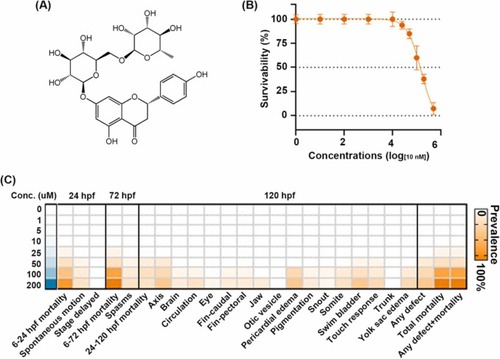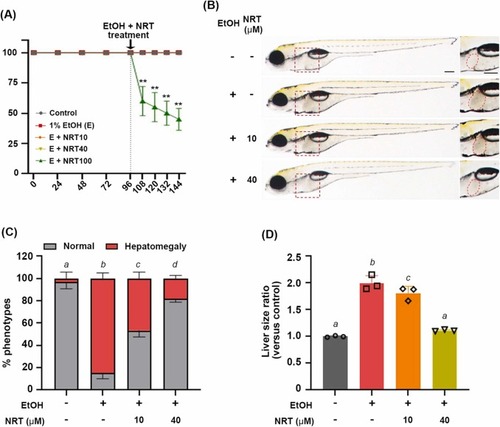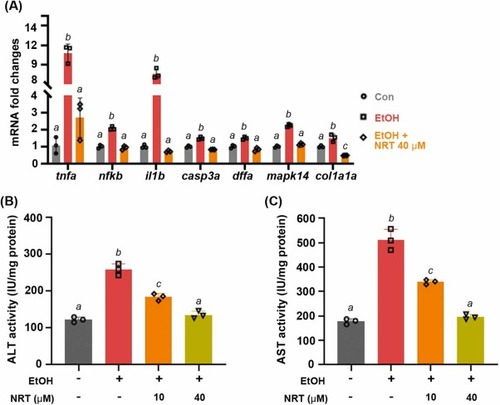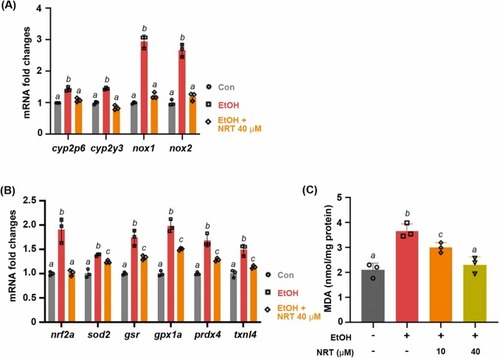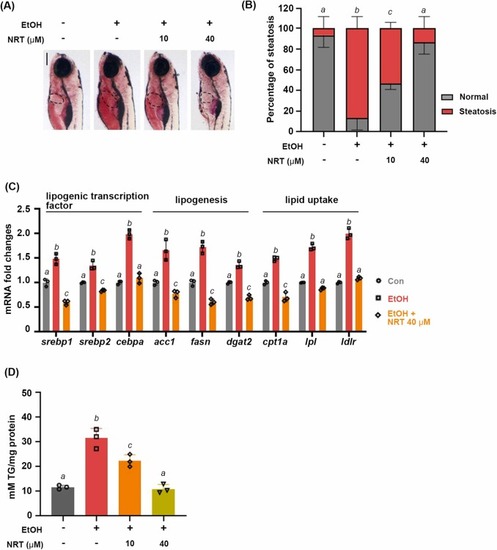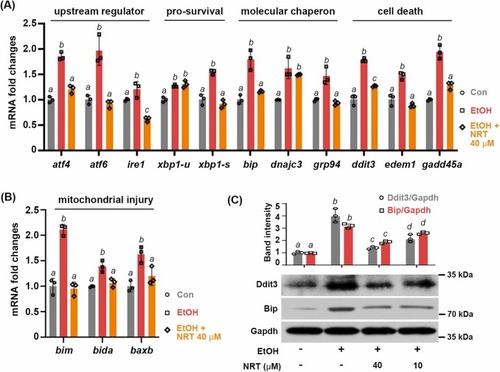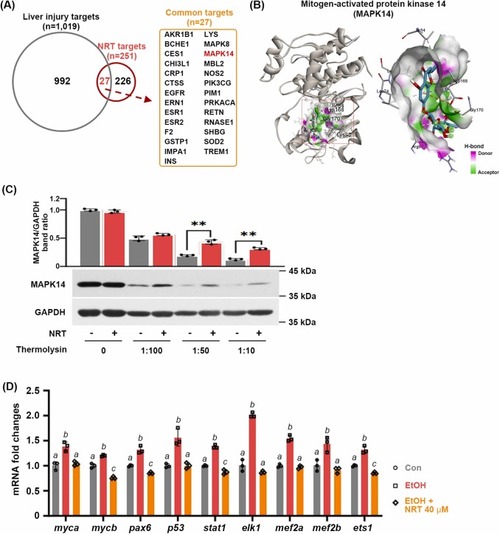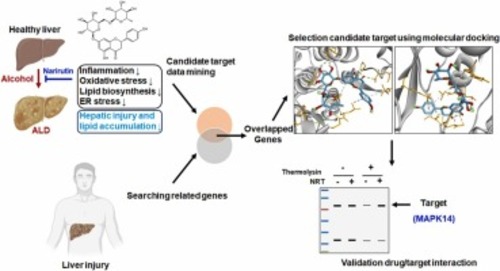- Title
-
Narirutin ameliorates alcohol-induced liver injury by targeting MAPK14 in zebrafish larvae
- Authors
- Park, K.H., Makki, H.M.M., Kim, S.H., Chung, H.J., Jung, J.
- Source
- Full text @ Biomed. Pharmacother.
|
Effect of NRT on zebrafish embryotoxicity. (A) chemical structure of NRT. (B) Embryotoxicity of NRT in zebrafish embryos. (C) A concentration-response heat map for morphological evaluation of developmental toxicity at 24, 72, and 120 hpf for NRT. Embryos were developmentally exposed (static non-renewal) individually from 6 to 120 hpf. Significance determined using Fisher’s exact test, p < 0.05, n = 15 per group, three independent experiments performed per concentrations. |
|
NRT ameliorated EtOH-induced morphological changes in zebrafish liver. (A) Survivability after EtOH with NRT treatment. (B) NRT was used to treat 4 dpf zebrafish for 48 h with 1% EtOH to detect the hepatoprotective effect of NRT. NRT resisted EtOH-induced phenotypic changes in zebrafish, scale bar, 0.2 mm. (C) NRT ameliorated EtOH-induced morphology changes and decreased the ratio of the percentage of liver defect phenotypes, n = 15 per group, performed triplicates. (D) An optical microscope was used to detect changes in liver size according to the treatment of NRT in the acute-EtOH zebrafish larvae models. The liver size was examined by image J software. The liver size was normalized to control group. Data are the mean ± SD; a,b,c,d mean values with different superscript letters are significantly different among the groups (p < 0.05). |
|
NRT improves inflammatory response and liver function in zebrafish larvae. (A) Real-time PCR analysis of the mRNA levels of inflammatory response genes. (B) Alanine transaminase (ALT) and (C) aspartate transaminase (AST) activity in zebrafish larvae after alcoholic injury with or without NRT treatment (n = 15/group, three experiments). The data are presented as the mean ± SD; a,b,c mean values with different superscript letters are significantly different among the groups (p < 0.05). |
|
Effect of NRT on alcohol-induced oxidative response dysfunction. (A) mRNA expression of genes associated with superoxide generation. (B) Relative mRNA expression of nrf2, sod2 and genes associated with redox balance. (C) Oxidative stress marker, malondialdehyde (MDA) content of EtOH-induced zebrafish larvae treated with the different concentrations of NRT (n = 15/group, three independent experiments). The data are presented as the mean ± SD; a,b,c mean values with different superscript letters are significantly different among the groups (p < 0.05). |
|
NRT reduces alcohol-induced liver steatosis in zebrafish larvae. (A) Oil-Red O staining was used to detect hepatic lipid accumulation in response to NRT treatment in zebrafish larvae. (B) Quantification of steatosis categorized “normal”, or “steatosis”. The bar chart indicates the percentages of each category in each group. N = 15/groups, three independent experiments. (C) mRNA expression of genes associated with lipogenic transcription factor (srebp1, srebp2, cebpa), lipogenesis (acc1, fasn, dgat2) and lipid uptake (cpt1a, lpl, ldlr). (D) The effect of NRT on EtOH-induced changes of TG level in zebrafish larvae. (n = 15/group, three independent experiments). The data are presented as the mean ± SD; a,b,c mean values with different superscript letters are significantly different among the groups (p < 0.05). |
|
NRT attenuates endoplasmic reticulum (ER) stress and mitochondria function in zebrafish larvae with alcoholic injury. (A) mRNA expression of genes associated with ER stress upstream regulator (atf4, atf6, ire1), pro-survival (xbp1-unsplicing, xbp1-splicing), molecular chaperon (bip, dnajc3, grp94) and cell death (ddit3, edem1, gadd45a). (B) Changes of genes associated with mitochondrial injury (bim, bida, baxb) in EtOH-treated zebrafish larvae by NRT (n = 15/group, three independent experiments). (C) Protein expression levels of Ddit3, Bip and Gapdh. Quantification of band intensity of Ddit3 and Bip was calculated by Gadph as a housekeeping protein (n = 5 biologically independent experiments). The data are presented as the mean ± SD; a,b,c,d mean values with different superscript letters are significantly different among the groups (p < 0.05). |
|
Network pharmacology analysis and target evaluation of NRT for alcohol-induced liver injury. (A) Venn diagram of the common target of NRT and liver injury. (B) 3D-dimensional view of the best target-ligand conformation of interaction between NRT and MAPK14. The interaction was analyzed using Discovery Studio Visualizer and represented H-bonds interaction. (C) DARTS assay using NRT (100 μM) showed the interaction between NRT and MAPK14. HepG2 cell lysates were incubated with NRT or vehicle (DMSO) for 30 min, followed by digestion with different dilutions of thermolysin (1:10, 1:50, and 1:100) for 10 min. Western blot analysis used antibodies against MAPK14 or GAPDH. MAPK14 level was normalized to GAPDH and fold change relative to control was calculated by using the MAPK14/GAPDH ratio. **, p < 0.01 (D) Validation of transcription factor genes within the MAPK14 signaling pathway by NRT. The data are presented as the mean ± SD; a,b,c mean values with different superscript letters are significantly different among the groups (p < 0.05). |
|
|

